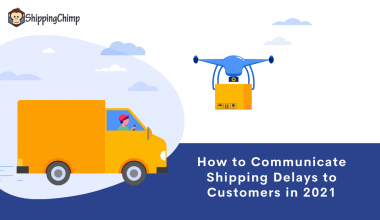Shopping for a product is pretty much thrilling, right? Until uncertainty kills it all!
Uncertainties like packages not being delivered on the due date, no updates from the brand, etc. spoil the entire shopping experience for most customers. If these things keep repeating, your customers are very likely to switch to another competitor.
In fact, Inactive customer support, no information on the package, makes the customers feel all the more disappointed.
Reducing this customer disappointment is what eCommerce brands must work on. Why?
- To retain customers
- To prevent product returns
- To strengthen your brand image
This blog is all about post-purchase dissonance – what is it and how eCommerce brands can actually reduce it.
So, let’s get started.
What is post-purchase dissonance?
Post-purchase dissonance simply said, is the disappointing state of mind of a customer after purchasing a product or service from a brand. This results in the customer either regretting the purchase or placing a return request for the product or service.
Here’s a simple example of post-purchase cognitive dissonance – A customer buys a dress from an eCommerce brand and regrets it immediately because the quality doesn’t match its price.
What causes post-purchase dissonance?
Post-purchase dissonance in consumer behavior means utter dissatisfaction with the consumers about a particular purchase.
To reduce post-purchase dissonance, it is important to identify the reasons causing it. Here are few common reasons behind post-purchase cognitive dissonance.
1. Product or Service Quality
A major reason behind post-purchase cognitive dissonance is poor quality of products or services. This reason crops up from the fault of the brand and their products. Several brands make tall claims and fake promises about product quality to sell them. The customers find these claims enticing and they end up buying the product.
The result?
Post-purchase dissonance. Soon after purchasing these products, the buyer realizes that the claims made about a product’s features were unreal. As the product fails to match the customers’ expectations, they are left with zero satisfaction.
2. Wide Range of Options
Another major reason behind post-purchase dissonance is the huge variety available to customers. When customers indulge in buying a product, they get a long line-up of alternatives. While several customers are happy with too many options, they often get confused to make the final purchase.
A great example of this would be a customer looking for an electronic gadget, say smartphones. Smartphones, nowadays, are available at a wide range of prices. The phones have a similar set of features, colors, and specifications. Except for the brands, there are no differences in products as such.
If the customer does not have a specific brand in mind, so many options will leave the buyer in utter confusion. So, even after making a purchase, the buyers may keep wondering whether they should have gone with another smartphone model.
3. External Influence
Post-purchase cognitive dissonance is often caused by external pressure on the buyers when they make a purchase. Immediate family members, relatives, friends, etc. may influence the purchase decision of the buyer.
A classic example of this would be buying a family car. While the father considers buying a sedan owing to the budget, maintenance, and needs, the kid may demand an SUV. This puts pressure on the father to get an SUV which consequently, gives rise to post-purchase dissonance.
4. Absence of Knowledge and Research
Several customers are impulsive buyers. At times, they indulge in buying something expensive only to realize later that the product wasn’t that necessary. The major reason here is the lack of knowledge and research before making the final purchase.
To prevent the feeling of post-purchase dissonance, it is a must for buyers to ask these questions:
- Is this product necessary for me?
- Where can I use this product?
- Do I have a budget to buy such a high-end product?
- Is the brand well-known and trusted?
- Will the features of the product address my pain points?
3 Useful Examples of Post-purchase dissonance
Here are 3 post-purchase dissonance examples that can help you get a clearer picture.
#1 Not renewing subscription
A common example of post-purchase dissonance would be not renewing a product/ service subscription. This may be due to various reasons like dissatisfaction with the quality, availability of better alternatives, or the product/service is no longer needed.
To keep the subscribers happy, create flexible subscription options.
Source: Wix.com
Here’s an example of flexible pricing for an eCommerce store. You can see how the store has created three different pricing plans based on offered values. This can be a smart way to avoid post purchase dissonance as it has something to offer for all groups of customers.
#2 Free Trials can cause post-purchase dissonance
Offering free trials is a proven strategy to increase conversion rates with an average of 57% of users buying a subscription after the free trial. It is an amazing way to earn customers’ trust.
However, potential post-purchase dissonance may still linger for the customers who use the free trial. To ease it out, let customers have the option of canceling the free trial when they want to. This surely means that you may lose out on a customer but it also keeps the good grace intact. Hence, you’ll still have the possibility of the customer’s return. This wouldn’t have been the same if the customer had to continue the free trial forcefully.
#3 Only positive reviews may not do the drill
A very popular example of post-purchase dissonance is a negative review. But these ‘bad’ reviews are actually not-so-bad.
67% of consumers prefer reading a mix of both positive and negative reviews. Plus, if you have only positive reviews and 5 shining stars, customers would have a suspicion about the reviews being paid ones.
So, keep it real by posting both positive and negative reviews. Also, respond to the negative reviews on social media to earn customer’s trust.
Zappos always takes negative reviews positively by posting a kind and sweet response to the buyers.
5 Best tips to reduce the post-purchase dissonance
Here are 5 tips that can help you mitigate post-purchase dissonance and keep customers coming back even more satisfied.
1. Be transparent about your return policy
Is hiding the return policy a clever strategy? Clearly, no!
In fact, this will only increase the chances of new customers leaving without even making a purchase. Also, not finding a clearly stated return policy increases the chances of post-purchase dissonance.
So, keep your return policy transparent. Think about long-lasting results and promote your product with confidence. This will improve your customer retention rate. You can try the best return management tools like ShippingChimp in order to make your return processes smoother.
2. Ace your transactional emails
This is a plain sailing task when it comes to reducing dissonance. The minimum that buyers expect is the free flow of communication after they make a purchase.
Amazon does a great job at this. They communicate with customers the whole time until the product arrives. They relay the order confirmation, estimated delivery, and post-delivery feedback email.
So, doing the minimum can save you from the regret that customers can feel right after the purchase. Try to strengthen communication with customers for your brand’s growth.
3. Maintain a post-purchase email sequence
Post-purchase emails can be tricky. They could be focused upon anything- feedback or something out-of-the-box like tips to use the product.
For example, Klayvio has launched a yoga mat that facilitates inner peace. But the plastic smell of the mat can easily lead to post-purchase dissonance. So, a smart way to handle this is to send an email to the customers a few days before the delivery. This email should state tips on how to get rid of that smell. This will be a great way to prevent dissonance.
4. Dig deeper and find the reason behind the dissonance
Easy return is fine but a strategic return policy is gold! Your return process can be an opportunity to know why your customers have returned the product. Using the return data, you can get actionable insights to make improvements.
For example, you can ask customers the reason for the return. The reason with the highest votes can be evaluated further so that you can reduce dissonance.
5. Offer exchanges proactively
Even before the customers ask, offer exchanges. Suppose your brand sells essential oils. When a new customer buys a bottle there are chances that they may dislike the fragrance.
Hence, to reduce the dissonance you can send a feedback email soon after the delivery. In this email, you can offer them an exchange option. They may or may not take it, but it will surely help in reducing the post-purchase dissonance.
Final words
Are you struggling to come up with a Post-purchase workflow for your shoppers?
ShippingChimp helps brands put their customers’ post-purchase journey on autopilot mode. This they enable by:
- Sharing branded shipping status updates
- Predicting delays and auto-generate an email apologizing for the impending delay
- Facilitating easy returns with a self-serve returns portal
Want to know more? Start your free trial now!





